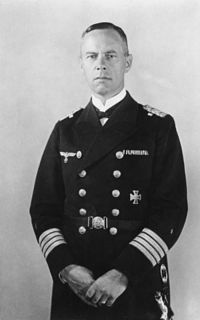Günther Lütjens Military person
Johann Günther Lütjens (25 May 1889 – 27 May 1941) was a German Admiral whose military service spanned more than thirty years and two World Wars. Lütjens is best known for his actions during World War II and his command of the battleship Bismarck during its foray into the Atlantic Ocean in 1941. In its aftermath, the episode entered into naval legend.Born in 1889, he entered into the German Imperial Navy (Kaiserliche Marine) in 1907. A diligent and intelligent cadet he progressed to officer rank before the outbreak of war, when he was assigned to a Torpedo boat Squadron. During World War I Lütjens operated in the North Sea and English Channel and fought several actions with the British Royal Navy. He ended the conflict as a Kapitänleutnant (captain lieutenant) with the Iron Cross 1st and 2nd class (1914) to his credit. After the war he remained in the service of the navy, now renamed the Reichsmarine. He continued to serve in torpedo boat squadrons eventually becoming a Commanding Officer in 1925. In the Weimar Republic era, Lütjens built a reputation as an excellent staff officer.In 1933, the year the National Socialists came to power under Adolf Hitler, the navy was remodelled again and renamed the Kriegsmarine. He soon became acquainted with Erich Raeder and Karl Dönitz; the only two Commanders-in-Chief of the Kriegsmarine in World War II. His capability and friendship led to his promotion to Kapitän zur See (Captain at Sea) and a sea command at the helm of the cruiser Karlsruhe. In the six years of peace he had risen to the rank of Konteradmiral Rear Admiral, a promotion conferred upon him October 1937.In September 1939 World War II began with the German invasion of Poland. Lütjens received the a prompt award of the Clasp to the Iron Cross 2nd Class (1939) three days later. His command of destroyer operations in the North Sea over the winter, 1939–40, earned him the Clasp to the Iron Cross 1st Class. On 1 January 1940, he was promoted to Vizeadmiral (Vice Admiral). In April 1940 he was given temporary command of the entire German surface fleet during the initial landing phase of Operation Weserübung, the invasions of Denmark and Norway. His actions earned him the Knight's Cross of the Iron Cross (Ritterkreuz des Eisernen Kreuzes) in June. The award was to express recognition of extreme battlefield bravery or successful military leadership.In the aftermath of the campaign he was appointed the commander of the German surface fleet and promoted to Admiral on 1 September 1940. He was involved in the tentative planning for Operation Sea Lion, the planned invasion of the United Kingdom, but the plans were shelved after the Battle of Britain. German intentions turned to blockade and Lütjens made the German battleships Scharnhorst and Gneisenau the centerpiece of his battle fleet; using the latter vessel as his flag ship. In January 1941 he planned and executed Operation Berlin, an Atlantic raid to support U-Boats in the Battle of the Atlantic by attacking British merchant shipping lanes. The operation was a tactical and propaganda victory. It came to a close in March 1941 when the ships docked in German-occupied France after sailing some 18,000 miles; a record for a German battle group at the time. His success led him to being chosen for further operations.In May 1941, Lütjens commanded a German task force, consisting of the battleship Bismarck and the heavy cruiser Prinz Eugen, during Operation Rheinübung. In a repeat of Berlin, Lütjens was required to break out of their naval base in occupied Poland, sail via occupied Norway, and attack merchant shipping. The operation went awry and the task force was soon spotted and engaged near Iceland. In the ensuing Battle of the Denmark Strait, HMS Hood was sunk and three other British warships were forced to retreat. The two German ships then separated. Three days later, on 27 May, Lütjens and most of the ship's crew lost their lives when Bismarck was caught and sank.In 1955 the Federal Republic of Germany was remilitarised and entered NATO. The Bundesmarine was established the following year. In 1967 this organisation recognised Lütjens and his service by naming the destroyer Lütjens after him.
Search
Military person
| allegiance | (to 1918) (to 1933) |
|---|---|
| award | |
| military operations | |
| military command | (1934–1935) (1940) (flagship) and (1940–1941) (flagship) and (1941) Torpedo boats T-68 T-21 A-5 A-20 and A-40 |
| service start | 1907 |
| service end | 1941 |
Topical connections
Günther Lütjens on Wikipedia
External resources
- http://www.battleshipbismarck.info/admiral_lutjens.htm
- http://www.bismarck-class.dk/bismarck/men_involved/luetjens.html
- http://www.channel4.com/programmes/the-battle-of-hood-and-bismarck/4od#2923185
- http://www.kbismarck.com/crew/lutjens.html
- http://www.maritimequest.com/warship_directory/germany/pages/destroyers/lutjens_d185_adm_lutjens.htm
- http://www.scharnhorst-class.dk/scharnhorst/history/scharnberlin.html
